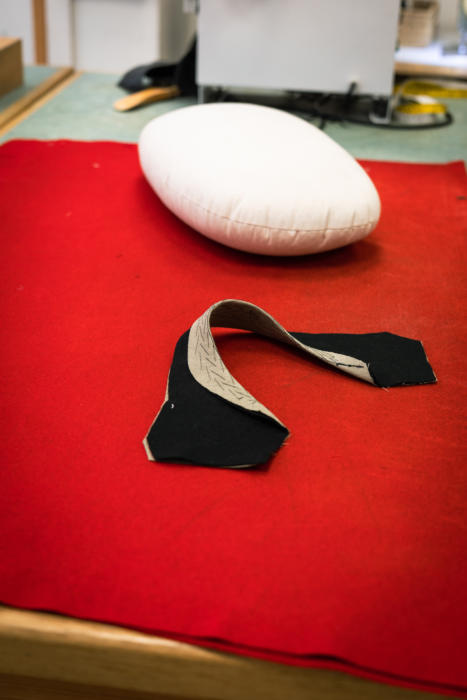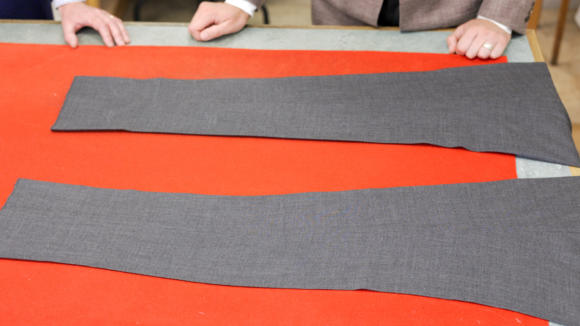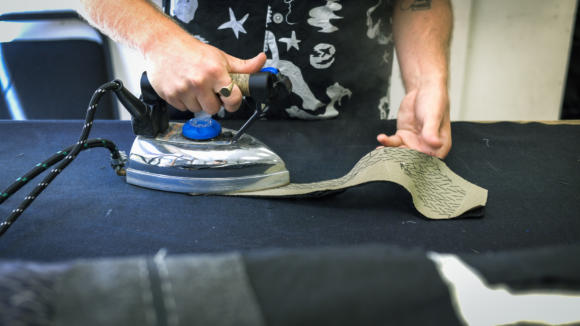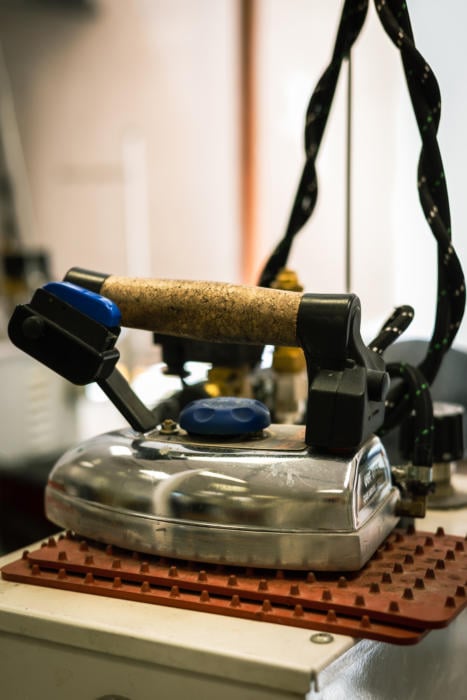Pressing: An unsung art of bespoke tailoring (video)
The first time I saw a tailor use an iron to shape cloth, I was genuinely surprised.
You wouldn’t think material would be able to be manipulated that much, using steam and pressure to turn a straight piece of canvas into the shape of a collar (above). But it’s routine for bespoke tailoring, and is used in many other parts a suit, as Nicholas De'Ath of Dege & Skinner shows us in today's video.
It’s Nicholas's third example that most readers will probably be familiar with: shaping the leg of a trouser so that it becomes a slight ‘S’ shape, with bulges at the thighs and calves (below).
Now I haven’t had this on all my trousers, and it hasn’t seemed to make a big difference when I have. But my body shape doesn’t necessarily need help in that area - and the important thing is that if a tailor feels it’s needed, pressing gives them the ability to do so.
The reason I was keen to do this video is that pressing, as a part of the craft of bespoke, doesn’t get talked about that much. It’s a lot easier to show basted jackets covered in white stitches, or someone hand-padding a jacket on their knee.
Pressing is noisy, hard to see, and the results are often hidden - either because the result is just a smooth finish (as on the shoulder seam) or because it’s actually on the inside, as with shaping the inlay.
So I asked Nicholas, who has cut me both a lovely linen suit and a summer jacket (worn here), to talk us through three major examples. We then run through a handful of others on a mannequin.
Many thanks to him, to the tailors who demonstrate the work for us, and to everyone else at Dege & Skinner for their help.
And thank you as always to the Campaign for Wool, who have supported all these videos. There is a dedicated channel for video on PS (see menu above) and other recent videos in this vein are:
- How to hem trousers (like a Savile Row tailor)
- How to sew on a button
- How a bespoke suit can be repaired
- How to look after tailoring
- How to look after suede jackets
- How to look after and wash knitwear
- How to press trousers
































interesting… I always thought that properly fitting smart trousers should have uninterrupted crease on the front and back… but if they are s shaped, the crease won’t be straight, no?
No Martins, the point is they still look straight because of the way they hang on the leg. That S-shape isn’t visible when you wear them
Simon the amount of shaping in the trouser depends greatly on the customers legs. There is no point in having a pronounced shape over the calf if the wearer’s legs are very slim. Nor is there any point in having a reduced back thigh if they are very stocky.
Bespoke tailors will always assess this as part of the figuration process, and the trousers will be cut/shaped accordingly.
Yes, thank you Ian, I made that point I think
This is fascinating. Therefore a trouser without the s shape will never really hang correctly?
From my military days, a heavy iron is essential and always iron through a piece of material. A damp tea towel is ideal.
It depends on the customer, to an extent the material, and it is a small effect. Some of the others we discuss have a larger effect in my experience, like that shaping and then tying in of the collar. But it is nice as it’s one of those little things a RTW or MTM house would pretty much never do
Do officers iron their stuff themselves? And could you by any chance recommend a “heavy” iron? I am always annoyed by how many streaks an oxford or linen shirt needs with my regular steam iron.
In my personal experience, Felix, it makes a big difference just getting a more expensive iron – it will usually generate more steam, which is what does most of the work. Also, with linen, spray it lightly beforehand, so it’s a little damp. That relaxes the fibres
I agree with Simon here. Recently I researched for new tools to improve my wardrobe care efficiency and had a look at multiple options. From Reliable corp. pro grade solutions to Samsung smart wardrobe/steam closet and everything in between. After exhausting all information available on the net I ended up with a simple 200€ Tefal steam generator I got from sale.
You don’t need to go for top end model with all the smart features, just get one that puts out decent amount of steam and then it can also do double duty as garment steamer. Tefal ones seem reliable enough for this kind of a product and are made in France if that means anything to you.
Hi Simon,
I agree with getting a good iron and can recommend Philips PerfectCare 9000 series Steam Generator irons. There is no temperature setting, it senses different garments and adjusts temperature and steam. Apparently, there is even a camera to check the cloth being ironed.
In the beginning, I tried it on tweeds and slowly moved to iron all my jackets, trousers, and everything else without using a cloth. Works on mixes of wool/silk/cashmere/linen. I like the ease of ironing and not having to worry about damaging the garment is a big plus. It is a worthwhile investment in my opinion and is not really more expensive than other high-end irons.
Cheers
Adam
Thank you Adam
By the way Peter, as I remember you wrote somewhere you live in Zuid-Holland, do you have a good dry cleaner and alterations tailor here?
There is an alterations tailor in Ridderkerk. https://www.winkelhartridderkerk.nl/pagina/winkels/kledingreparatie-stomerij-ridderkerk
They also do dry cleaning- but I’ve only had trousers cleaned there which seem ok.
And at least one in Rotterdam (Maestro). Not used it though.
Thanks a lot – I’ll try them!
The craft and the shaping of bespoke garments are amazing. People will often understand the art and effort behind a beautiful painting or sculpture, but not in bespoke clothes or shoes. They will often argue why they themselves need to have a certain salary, but show no understanding in other peoples salaries. Like the salary of artisans reflected in their products(time and effort). With that said, I find the upkeep of these kinds of garments a bit hard. There is only so much you can do at home and most countries or people don’t have a dry cleaner or bespoke maker trained in the art of ironing bespoke products nearby. If turned in to a regular dry cleaner, they will often press the lapel and everything flat. What’s your thought on this, unless you plan on bringing or your bespoke garments abroad just to repress them?
It’s certainly an issue, Phil. We have covered some services that do this, such as Michael Norman and The Valet (previously George the Presser). And George in particular has expanded into offering great dry cleaning too under that new brand. Rave Fabricare also comes highly recommended in the US.
But in the end, it is a lot easier if your bespoke tailor is local, and you can bring your things in now and again for a refresh (and as you say, recognise the value and cost of this).
We do have videos (see the video section) on the little things you can do at home, particularly to take creases out of knees and the small of the back, and elbows. Plus keeping a crease of course. They’re in the Video section of the site (see menu). Apologies if you were already aware of all those!
Yes, this is what I mean by local, as we are not all located in the States or Great Britain. Basic ironing at home, I think most of us already are aware of. The lack of availability of having a proper pressing service is an issue I’ve found that we do not talk a lot about in menswear.
This is a great point. The last tailor in my half of New Zealand died recently – there’s now no one left who can do this sort of work 🙁 time to get my hands dirty I guess!
I agree – here in Scandinavia you can also pretty much forget about finding a good “presser”/dry cleaner
Simon, this is off topic; however, my question is regarding visiting England in mid October. I will be traveling there for two weeks and need guidance on how to plan my casual wardrobe with regard for the weather. I desire to pack using a carry on and small backpack. What would you suggest?
It will depend considerably on how smart you want to dress, given your style and what you will be doing. Perhaps start by giving me an idea of what you would normally wear, and I’ll suggest tweaks to fit the weather?
Work is smart casual such as chinos with OCBD or spread collar and jacket/sport coat. Very rarely with a tie but perhaps a pocket square. Shoes are loafers or brogue oxfords.
Cooler weather may be cord trousers or medium wash jeans with check/stripe shirt and solid crew neck or v neck sweater/jumper. I also favor tweed jackets. Casual weekends are jeans with polos or t-shirts in warm weather and chukkas or occasionally white basic sneakers (Puma Roma Italy…a nod back to the late 1960’s). Have worn more linen and performance fabrics this summer due to the hot humid climate in East Tennessee.
We will be doing a lot of walking to explore villages and towns and will have several days in London. I would like to fit in and be well dressed and not standout as a tourist.
A big challenge is to plan carefully to have pieces that work together and able to pack in a carry-on and small backpack.
I appreciate your thoughts and suggestions.
Hey Tony,
To be honest I think it’s unlikely you will stick out in London. It’s a very varied and multicultural city, and you will be among a huge variety of people and forms of dressing. You may do outside London, but that would only be because you dress a little smarter than most. If you tended towards the more casual end of what you normally wear, that would be fine – more jeans, fewer jackets. But then, you might not want to.
Overall I wouldn’t worry too much about it. These clothes are so universal now that there won’t be many differences from what you see in the US
Thank you Simon. Have a great day!
-Tony
Thanks Simon – so if you were to hand wash the trousers you would probably loose that S shape i guess.
Even just through wear you would do as well.
But can I ask why you mention hand washing? Bespoke trousers should never really be washed, only pressed, steamed or dry cleaned.
I must say that I have hand washed a few after a few scares from dry cleaners and the results were pretty good. But then I may have not noticed the particular shaping being lost. If you have a pair of wool trousers that you may want to try the process with, this is what I did:
I have put them folded neatly in lukewarm water with little wool wash. I have changed the water a couple of times. Then I have put them again neatly folded in a very tight net and gave them a spin at the 400 (other times I have used a towel to remove the excess water). Then i have used an iron to give them back the shape and I have finished drying them flat. I did not take photos of the before and after but I cannot see any visible differences.
Simon,
Obviously they are using an industrial iron and know what they are doing, but, with a at-home iron, could you conceivably make slight alterations to your trouser’s shape? Such as minutely expanding the thigh or calf.
Yes, though I’m not sure I would try it. You would be very annoyed if you did anything permanent to the shape, and the amount desired would be something a cutter would need to have a view on as well
How often, if ever, do you return a suit to the tailor to be re-pressed? Or does your cleaner have the skill to do so with every cleaning?
I generally use a cleaner, such as The Valet or Michael Norman (see other comment above on them), who are also great pressers. Usually it only goes back to the tailor when an alteration or a repair is needed
Hello Simon, why do you not wear a tie? I think so much gets lost without it…
It’s a good question Tyler, and one that deserves its own post perhaps, like the one I did here on not wearing pocket handkerchiefs as much.
I do still wear a tie, but I also don’t want to ever be antiquated or out of my own time, and there are precisely zero people around me – where I live, or in Mayfair – wearing a tie unless they are a tailor or similar. Also, when this video was shot it was very hot!
One of the most underrated aspects of bespoke. Thank you Simon for highlighting it in such a informative way. This is one of the things that makes Permanent Style unique.
Thank you Andreas. Always lovely coming from your good self
A great post/video. Attention to details such as this helps explain why bespoke costs what it does, and why properly done, the fit is so far beyond RTW.
Exactly
Sad day
The title of the post certainly did not look that enticing to me, but I’m glad I watched the vid! Interesting stuff. He also wanted to say something about shaping linen, do you know what he wanted to say?
Also like another commentor said, this would’ve been an excellent excuse to wear a tie! I know I’m always looking for them..
Thanks Nils, pleased you liked it.
The point about linen was just that it was harder to shape than wool – though a little easier than cotton.
This was a very interesting and informative article. I had never considered the possibilities that pressing offered. I’ve been reading your blog for a little over 2 years and while I appreciated the craftsmanship in bespoke I never thought the value added was worth the extra cost. This changed my view.
That’s lovely to hear Ira. It really is incredible the amount of work that goes in – I should show something be ripped down and remade sometime as well, it’s so much just for the next fitting alone
First off, wow. I really enjoyed this video. As fabric enthusiasts, my spouse and I talk not infrequently about pressing. Really glad to see it featured here. Completely underrated.
Throughout my university days we measured the value of a lecture by how thought provoking it was, the lectures that led one to ask more questions were considered the cream of the crop. Likewise, your video left me with more questions than answers.
So here’s my question: I’m considering having my first pair of bespoke trousers commissioned. I’m a unique size and my office is largely dominated by separates so shirts and trousers are my go-to. I’m fairly fit (swimming, running, hockey) with big quads and short legs. Before this video I was going to talk to my tailor about pleats, but now I’m curious about how far pressing goes. I suppose a good tailor will have a holistic sense of how a garment comes together, but I suppose my question is how far does pressing go when considering cutting?
Hi Simon,
Great to hear, thank you.
I think something like pleats might still be a good idea with that physique, or at least a roomy trouser that can hang fairly straight. The shape gained through pressing won’t make a huge difference, and it’s something a tailor would probably incorporate anyway, regardless of the style of trouser.
I hope that answers your question – do shout if there are any more.
What a refreshing post that reflects one side of the tailoring business that’s vital in making sure a suit etc is correctly hand finished and pressed. While dry cleaning gets the bad press it’s actually the pressing/finishing that can ruin a garment with incorrect creases/ seam impression marks to fabric/ material stretching/ shine moir marks. All caused by the non skilled uneducated presser.
Hi Simon,
Do you know why traditional tailors prefer to use heavy dry irons over steam ones?
Is it because the steam may damage the fabrics and, above all, the seams?
Thank you also for this fantastic and instructive report: it’s paramount to communicate all the hidden work involved in bespoke tailoring in order to appreciate its full worth!
Cheers!
They do use steam ones though Luis? The ones in this video all use steam?